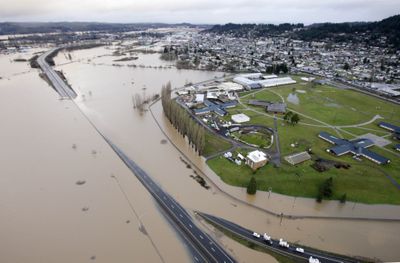Flooding, landslides cripple West Side
Road closures halt state commerce

ORTING, Wash. – Reeling from a deluge of torrential rain and melting snow, much of Western Washington became a virtual island Thursday as flooding and avalanche conditions cut off all major transportation arteries.
More than 30,000 residents who had been evacuated tried Thursday to outsmart the forces of nature and creep home. Despite the conditions, there were few injuries and isolated flooding of homes.
The region’s major airports were operating normally, but officials said it could be days before a flooded section of Interstate 5 near Chehalis reopens, as the last of more than 30 rivers running above flood stage across Western Washington were expected to crest today.
“We have totally stopped commerce in this state,” Transportation Secretary Paula Hammond said. The I-5 shutdown, she said, was costing Washington $4 million a day.
In Orting – a town in the shadow of Mount Rainier that was surrounded by the turbulent Puyallup and Carbon rivers – thousands of residents who fled their homes Wednesday slowly began returning, in some cases to deluged driveways and flooded garages.
“The water came up to within an inch of the back door. The garage is full of water. It’s never flooded like this, ever,” said Don Steed, whose backyard on Voights Creek was a muddy torrent swirling around his riding mower, barbecue and Volkswagen Beetle.
National Guard troops helped officials in Orting assess the damage, while state transportation workers struggled to create a 400-mile I-5 detour. That flooded section of roadway normally is traveled by 10,000 trucks a day.
At least 19 counties – mainly in southwestern Washington – had declared states of emergency, while voluntary evacuations in the Tacoma suburb of Fife brought the trouble to the fringe of the state’s population core.
Warm, wet air from the Pacific had swept over a large snowpack, sending torrents of water racing out of the mountains.
“The weather has already turned more showery, and the … significant precipitation is over. But it will take a while for the rivers to drain all the water,” said Chris Burke, meteorologist for the National Weather Service. “It may be Saturday before all the flood warnings have ended.”
Trucker Ken Walker, cooling his heels near Chehalis, said he had set off from Spokane toward Seattle when he learned that Snoqualmie Pass was closed. He diverted south to the Oregon border and was making his way back up I-5 when, once again, he came to an unwelcome halt.
“I got to here and they closed the road in front of me,” he told Northwest Cable News. “There is no other way in, unless you’ve got a boat.”
In the Cascades foothills, the Snoqualmie River crested at a record 8 feet above flood stage, and rescuers helped residents in the towns of Snoqualmie and Duvall evacuate along inundated streets.
Flooding is a regular occurrence in the Northwest, and many of the communities under voluntary evacuation this week have been there before: Many Orting residents were forced out of their homes as recently as November and also in 2006.
Yet Mayor Cheryl Temple said never before had she had to send firetrucks up and down the streets of Orting with loudspeakers, urging the town’s 26,000 residents to move to higher ground, as she did Wednesday afternoon.
“The rise of water in the rivers was more significant than I have ever seen, and I have been here 22 years,” Temple said at her City Hall office, which was beginning to operate normally again Thursday. “We could not ignore those numbers. It was pretty scary.”
By and large, the locals took it in stride. Orting lives under the constant, if remote, possibility that a volcanic eruption of Mount Rainier could send down a deadly wall of mud, trees and rocks. Drill sirens go off periodically, and “volcano evacuation routes” are posted prominently around town.
“They say it’s the most dangerous city in the U.S. because of the mountain, and two major rivers running through here,” said Shannon Shaw, who stood on one end of a flooded road with her husband and two daughters, unable to return home to see if their house had survived a marauding tributary of the Puyallup River.
“But the summers are so beautiful. It’s so nice to walk along the river; you can ride horses up on the levee road.”
A few miles away, Barbara and Douglas Peterson had a rushing creek backed up to the edge of their deck, and a pond where much of their yard had been. After three evacuations in three years, they were ready to move.
“There’s no sense staying here,” Douglas Peterson said. “I’ve got nothing but mud … out there I’ll have to clean up again. Water in the garage. The county has talked about buying all these places and clearing it out, and I think it’s probably time to move.”